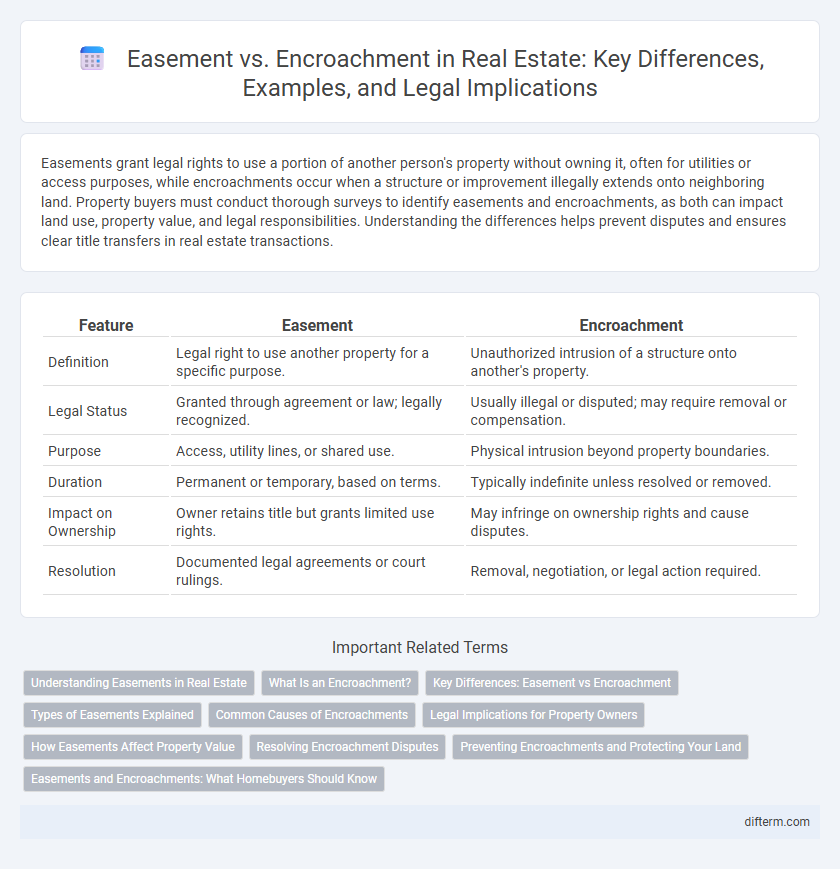Easements grant legal rights to use a portion of another person's property without owning it, often for utilities or access purposes, while encroachments occur when a structure or improvement illegally extends onto neighboring land. Property buyers must conduct thorough surveys to identify easements and encroachments, as both can impact land use, property value, and legal responsibilities. Understanding the differences helps prevent disputes and ensures clear title transfers in real estate transactions.
Table of Comparison
| Feature | Easement | Encroachment |
|---|---|---|
| Definition | Legal right to use another property for a specific purpose. | Unauthorized intrusion of a structure onto another's property. |
| Legal Status | Granted through agreement or law; legally recognized. | Usually illegal or disputed; may require removal or compensation. |
| Purpose | Access, utility lines, or shared use. | Physical intrusion beyond property boundaries. |
| Duration | Permanent or temporary, based on terms. | Typically indefinite unless resolved or removed. |
| Impact on Ownership | Owner retains title but grants limited use rights. | May infringe on ownership rights and cause disputes. |
| Resolution | Documented legal agreements or court rulings. | Removal, negotiation, or legal action required. |
Understanding Easements in Real Estate
Easements in real estate grant a property owner the legal right to use another person's land for a specific purpose, such as access or utilities, without owning the land. Unlike encroachments, which involve unauthorized physical intrusion of a structure or improvement onto another property, easements are typically documented and legally enforceable agreements. Understanding the types of easements--such as appurtenant or in gross--and their implications is crucial for property transactions and title clarity.
What Is an Encroachment?
An encroachment occurs when a property owner's structure, such as a fence, building, or driveway, intrudes onto a neighboring property without permission. This unauthorized intrusion can lead to legal disputes, affecting property boundaries and title clarity. Identifying and resolving encroachments is crucial in real estate transactions to ensure clear ownership and prevent potential conflicts.
Key Differences: Easement vs Encroachment
Easements grant legal rights for one party to use another's property for specific purposes, such as utility access or shared driveways, without owning the land. Encroachments occur when a property owner physically intrudes on another's land, like fences or structures extending beyond boundary lines. The primary distinction lies in easements being legally approved uses, while encroachments often involve unauthorized occupation or use of property.
Types of Easements Explained
Easements in real estate include appurtenant, which benefits adjacent property, and easements in gross, granting rights to individuals or entities without ownership. Prescriptive easements arise from continuous use without permission, while express easements are formally recorded agreements. These types ensure legal access and usage rights, differing significantly from encroachments, which involve unauthorized intrusions on property boundaries.
Common Causes of Encroachments
Common causes of real estate encroachments include fence disputes, driveway overlaps, and unauthorized building extensions onto neighboring properties. Tree roots or branches extending beyond property lines often lead to encroachment claims. Survey errors and unclear boundary descriptions also frequently result in encroachment issues between adjacent landowners.
Legal Implications for Property Owners
Easements grant legal rights to use another property for a specific purpose, often documented and enforceable through property deeds, which can affect property value and usage rights. Encroachments involve unauthorized physical intrusion onto a neighboring property, potentially leading to legal disputes, boundary adjustments, or claims for removal or compensation. Property owners must understand these distinctions to manage legal risks, protect property rights, and ensure compliance with local land use regulations.
How Easements Affect Property Value
Easements grant legal rights for others to use a portion of a property, which can affect its market value by limiting the owner's full control over the land. Easements for utilities, access roads, or shared driveways may reduce privacy and development potential, impacting buyer appeal and resale price. However, well-managed easements that provide necessary access or infrastructure often maintain or even enhance property value by ensuring functionality and compliance.
Resolving Encroachment Disputes
Resolving encroachment disputes often involves a detailed property survey to accurately establish boundary lines and the extent of the intrusion. Legal remedies such as negotiation, mediation, or court actions can clarify property rights and potentially result in compensation or modifications to property boundaries. Establishing an easement agreement may also provide a formal resolution by allowing limited use of the encroached area while preserving ownership rights.
Preventing Encroachments and Protecting Your Land
Implementing precise property surveys and installing visible boundary markers are essential steps in preventing encroachments on real estate. Regularly reviewing deed descriptions and consulting with legal professionals help landowners protect their property rights against unauthorized use. Taking proactive measures such as obtaining easement agreements can clarify access rights and reduce disputes related to land boundaries.
Easements and Encroachments: What Homebuyers Should Know
Easements grant a legal right for someone to use a portion of a property for a specific purpose, such as utility access or a shared driveway, without owning it. Encroachments occur when a structure or improvement, like a fence or building, intrudes onto a neighboring property, often leading to disputes or the need for resolution through legal means. Homebuyers should thoroughly review property surveys and title reports to identify easements and encroachments, ensuring they understand potential restrictions or conflicts affecting the property's use and value.
Easement vs Encroachment Infographic

 difterm.com
difterm.com